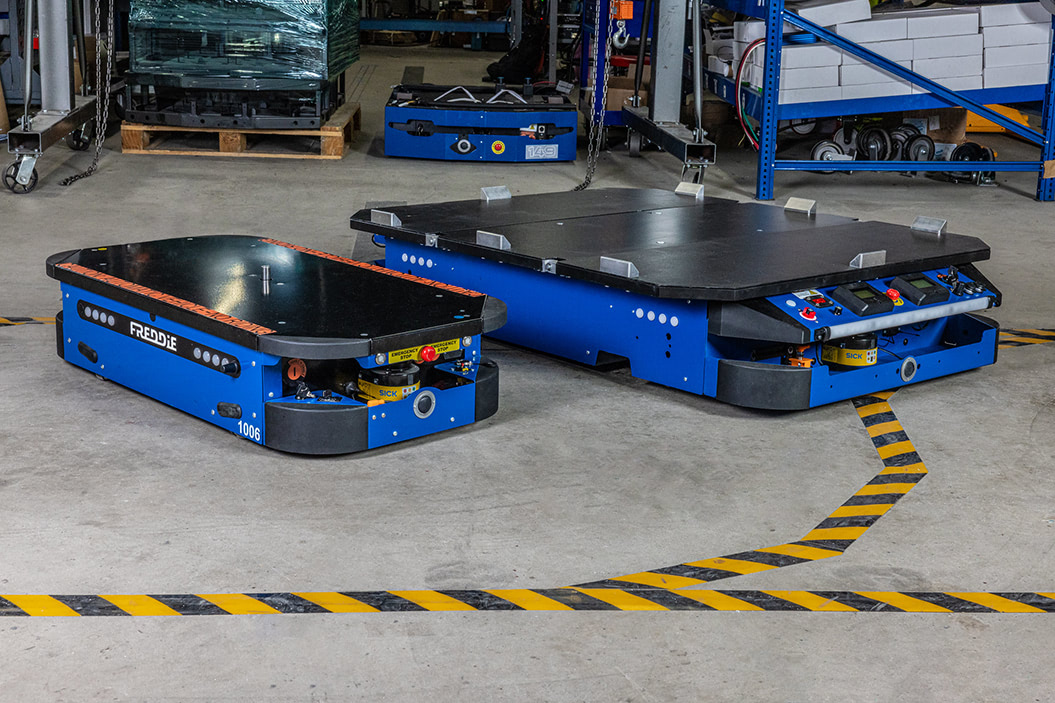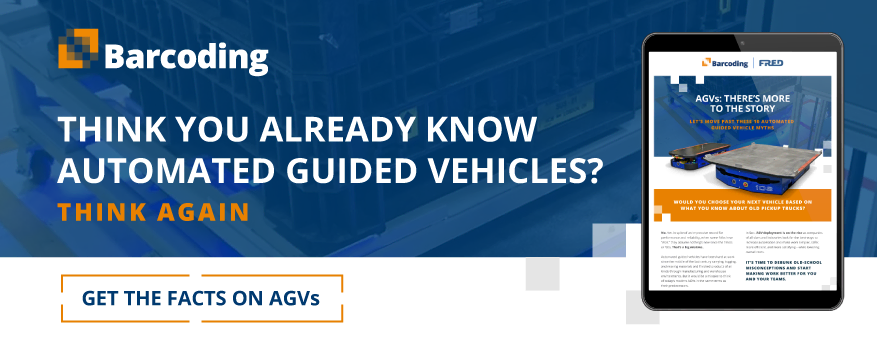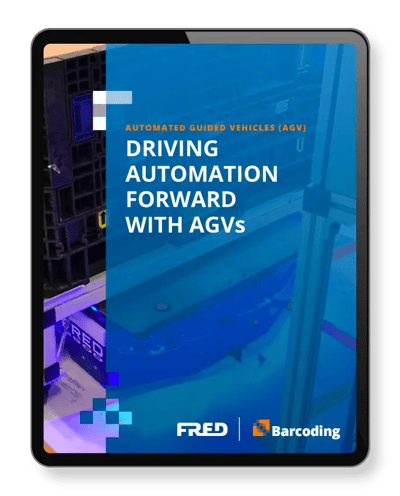Businesses everywhere and across all industries are facing increased pressure to reduce costs, improve efficiency, and address persistent challenges like a shortage of available workers.
So it’s not really a surprise that many operations managers are taking a closer look at ways they can introduce automation into their facilities and workflows. But for some, fears of high upfront costs hold them back from making changes that could have a virtually instant impact on productivity and efficiency—without adding new employees to the mix.
Automated guided vehicles (AGVs) offer a particularly flexible automation solution, often at a surprisingly affordable price point compared to other options, especially compared to human-operated equipment like fork trucks and pallet jacks.
At the same time, let’s not forget that total cost of ownership isn’t the same as purchase price. Maintenance, energy, human-operator related costs, insurance, potential damage to facilities and products…It's easy to see that TCO is a holistic value, not just a price tag.
In this article, we’ll take a closer look at key factors influencing AGV costs versus the traditional manual material handling methods most manufacturing and warehousing facilities rely on.
What Impacts the Cost of an AGV?
Several main factors influence the initial purchase price of an AGV:
- Payload capacity—How much weight can it move? Larger capacity equals higher cost
- Navigation technology—Laser, vision, inertial, and magnetic navigation systems can have widely varying costs
- Software—More robust software with additional capabilities typically adds cost (and sometimes, it’s capability overkill for the task at hand)
- Customization—Integration with existing software systems and specialized form factors or configurations can drastically increase costs
- Support options—Technical support, user and maintenance training, maintenance contracts, and extended warranties can all add cost
- Brand reputation—Established equipment manufacturers often command higher pricing
You probably also wonder if it’s cheaper to procure material handling equipment, such as AGVs, from overseas or U.S.-based providers. It’s a legitimate question that often requires a little digging beyond sticker price to determine an answer.
In the wake of global supply chain disruptions, experiences with shipping delays, mistakes, and rework have more North American facilities looking closer to home. While component costs may be higher, partnering with an agile OEM provider that’s within a time zone or two, and delivering over land and not by boat, can help control long-term total cost of ownership.
How Do AGVs Compare to Forklifts and Pallet Jacks?
Before diving into a side-by-side comparison, let’s not miss this significant fact: A basic AGV moves objects from point to point.
Lifting and placing objects on an AGV, and removing and placing items at their destinations, demand collaborative workers and/or handling equipment. Specialized AGVs can include some or all of the capabilities needed to lift, place, or transfer loads—and that, too, adds cost.
A basic AGV can make automation accessible at a much lower upfront investment than traditional material handling equipment.
The hypothetical, estimated values below help illustrate potential cost differences, though every customer's situation will be specific to their needs and operations:
|
Cost Factor |
Basic AGV |
Forklift |
Pallet Jack |
|
Initial Investment |
$35,000–$45,000 (with support) |
$25,000+ |
$500+ |
|
Annual Maintenance & Repairs |
$3,000 |
$1,000 |
$50 |
|
Annual Operating Costs |
$1,000 |
$2,500+ (fuel or charging) |
negligible |
|
Annual Depreciation |
$15,000 |
$2,500 |
$50 |
That AGV has a higher upfront cost, but it quickly pays for itself by eliminating the ongoing expense of human operators—and those costs extend well beyond a worker’s wages.
How Human Labor Costs Impact TCO of Fork Trucks, Pallet Jacks, and AGVs
Adding up the full multi-year cost of human labor helps illustrate the value of automation to deliver efficiency, worker safety, and quality improvements that add up to…well, money.
The numbers below are hypothetical; real costs to an individual company depend on wages, benefits, and other variables unique to each business. This comparison assumes a facility runs three shifts.
|
Annual Cost Factor |
AGV |
1 Worker x 3 Shifts |
|
Wages |
None |
$60,000+ |
|
Benefits |
None |
$12,000+ |
|
Training & Certification |
$2,000 |
$4,000 |
Don’t forget that an AGV can significantly boost productivity. Even moving at lower speeds, with no breaks, fatigue, or distractions, an AGV can carry significantly greater weights than any human worker, and at a consistent, steady pace. Precision navigation reduces errors—as well as the likelihood of lost-time accidents and damage to property and products.
And 24/7 operation means that even after shift workers call it a day, an AGV can keep moving tools, products, materials, dunnage, you name it. Workers can return to lines stocked and ready for maximum productivity the next day.
Keep in mind the added costs related to keeping human workers on a task. Increased risk of accidents can mean higher insurance costs—certainly, actual accidents result in major expenses. That makes accident-prone areas like blind corners, tight spots near conveyors, and densely-packed production lines ideal opportunities to automate and see a fast path to ROI.
How Long Does it Take for AGV Adoption to Pay Off?
For a facility operating two or three shifts a day, most companies can expect to recoup the initial AGV investment in under two years. Those running three shifts may realize full ROI in less than a year—and some see ROI for AGVs in just a couple of months. (Yes, really!)
Key factors influencing time to ROI include:
- Hours of operation—More shifts lead to faster payback
- Labor costs—Higher wages mean faster breakeven
- Productivity gains—Greater output equals increased revenue
- Safety impact—Reducing accidents, incidents, and lost time adds up to meaningful savings
- Flexibility—Basic AGVs that can be easily redeployed where needed most add agility value
- Quality improvements—Reduced errors and damage boost the bottom line
Eliminate Barriers: How You Can Pilot Test an AGV
Getting started with an AGV can be as simple as a rental option, which has the potential to keep costs well under capital expenditure thresholds. A rental option can enable you to “try before you buy” with a single AGV, over a period that enables your team to really evaluate outcomes and performance improvements. That, in turn, powers your purchasing request with the data you need to support your automation investment.
Starting small with a pilot AGV program is an affordable way to validate automation’s benefits for your specific application. Hands-on experience helps build familiarity and confidence to align stakeholders from workers on the floor to the C-suite, setting the stage for smoother transformations in the future.
Robot-as-a-Service (RaaS) options also open the door for introducing automation even in operations that don’t have their own robust IT infrastructure or department support.
That points to another key factor in successful implementation: solid, ongoing support from dedicated experts. Barcoding’s PreLive, GoLive, and StayLive Services™ deliver valuable, expert support every step from procurement through to end-of-lifecycle equipment refresh.
- PreLive advisory services can help build your business case and make the best possible procurement choices.
- GoLive assistance ensures minimally invasive installation, testing, troubleshooting, and training.
- And StayLive support can include multi-year maintenance contracts and parts availability to maximize uptime and extend the useful product life of Fred AGVs.
Ready to Take the Next Step with AGVs?
How about saving a few steps—or a few thousand? AGVs not only streamline workflows, reduce steps, increase consistency, and make work safer; they also present an economical material handling choice. For those who remember the AGVs of yore, it might be time for a fresh perspective on automation technologies.
Discover for yourself how today’s modern AGVs have evolved to meet the changing needs of the industrial workplace. Download our guide to start busting AGV myths that persist in your facilities.



